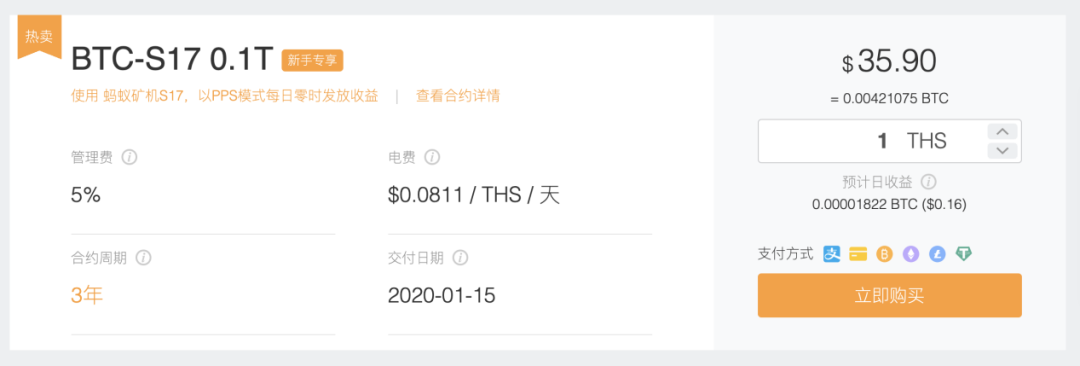Counting mining 2019: the seven major mining pools have annual revenues of more than 10 million and a variety of cloud computing power contract losses

Text, Data and Visualization | Carol Editing | Bi Tongtong
Data Partners | Produced by BTC.com | PANews Public Account Backstage Reply "Draw" to Send Bitcoin Benefits
The mining circle is a mysterious and closed circle for many people. Earlier, PANews and Tencent News jointly produced "Miner Besieged City" telling the rumbling sound of the mines that screamed through the day and night. Under the bitcoin "roller coaster" market, miners, mine owners, miners, and "inverted masters" interpreted the mines. Circle "Lake".
- 27 blockchain companies' performance forecast last year
- Blockchain asset tokenization helps local debt issuance
- Bitcoin's third wealth and crisis halved
If these real stories are just a microcosm of the mining circle, then the data can restore the true appearance of the mining circle in 2019. Did you make money in the mining circle in 2019? How will this mysterious niche industry develop in the future? Above we reviewed the growth of bitcoin computing power and mining pool competition in 2019. This article will tell you which mining pools are the most profitable in 2019 and whether cloud computing power is worth investing in.
This article is "Review of Bitcoin mining data in 2019 (below)", click to view above (the number of mining 2019 | mining difficulty increased by 97.67% throughout the year, which mining pool is on the right pace? )
PAData Insights:
- The Bitcoin mining pool's annual average miner fee income exceeds $ 4.2853 million, and the highest income BTC.com reaches $ 26,225,600.
- According to the general percentage of FPPS, the estimated average annual income of the mining pool is more than USD 4.53 million, of which the highest income BTC.com exceeds USD 26.49 million.
- There are six companies with an estimated annual income of more than 10 million US dollars, including F2Pool, Poolin, AntPool, SlushPool, ViaBTC, and BTC.TOP.
- The average empty block rate of the major mining pools in 2019 is about 0.55%, which is lower than the entire network of 0.58%.
- The average cost per TH / s of 28 cloud computing power products (including computing power cost and power cost) is about 0.1363 USD, while the average revenue is only 0.0155 USD / T.
- The contract period of 28 cloud computing power products is not directly proportional to the level of income. The longer the contract period, the higher the net income.

Mining is one of the few sustainable profitable formats other than exchanges.
According to PAData's earlier revenue statistics for EOS nodes, the average annual income of the elected nodes is only about 108.98 million US dollars, and the annual average miner fee income of the Bitcoin mining pool exceeds 582 bitcoins. The annual average currency price is estimated at USD 73.5251, which is equivalent to USD 4.285 million. Among them, BTC.com, which has the highest miner fee income, earned approximately 26.226 million US dollars throughout the year, and the mining pools that earned more than 10 million US dollars of miner fees include F2Pool, AntPool, Poolin, SlushPool, ViaBTC, and BTC.TOP.

If calculated based on the annual average computing power of the major mining pools, then with 1% of the computing power of the entire network, the annual miner fee will be up to 1.84 million US dollars.
Under the scale effect of bitcoin mining pools, the difference in fee income between large and small mining pools is relatively large. There are 10 mining pools with annual fee income of less than 100,000 US dollars. These mining pools face greater pressure for survival. . The income composition of the mining pool is mainly the extraction of mining revenue. In addition to the miner fees, the mining revenue includes a block reward of 12.5 bitcoins per block. If calculated according to the general percentage of 3% in the FPPS model, then the bit Bitcoin's largest mining pool, BTC.com, has estimated annual revenue of approximately $ 26.495 million. F2Pool also has an estimated annual income of more than 20 million US dollars, reaching 2006.77 million US dollars. In addition, the estimated annual revenue of Poolin, AntPool, SlushPool, ViaBTC, BTC.TOP also exceeded $ 10 million.
According to statistics, the average miner fee for each major mining pool in 2019 accounts for about 2.89% of total revenue, which is slightly higher than the overall average level of the Bitcoin network of 2.80%. About 5.2 billion US dollars, Coinbase has become the "king of gold".) This may be a reflection of the scale effect of the mining pool, or it may be more "lucky", and the transaction fee included in the block is higher.
Among them, Eobot's miner fees accounted for the highest proportion of total revenue, reaching 9.31%, and 1M1X also reached 7.08%. In addition, mining pools with higher miner fees accounted for Hummerpool, BitMinter, Bixin, and Solo CK, which all exceeded 3.5%.

In addition, the average empty block rate of the major mining pools in 2019 is about 0.55%, which is lower than the entire network of 0.58%. Among them, SecretSuperstar has the highest empty block rate, reaching 9.09%. Above average are Hummerpool, Bixin, BTC.com, AntPool, Huobi.pool, BytePool.

Empty blocks are blocks that do not contain transaction information, but still contain Coinbase. Miners can normally earn revenue by mining empty blocks. Since the mining pool is operated continuously, in order to obtain higher profits, it is necessary to find as many blocks as possible, and empty blocks will be mined in the process. The controversy about empty blocks is mainly focused on whether mining empty blocks in the mining pool will cause network congestion, but as far as the current situation is concerned, but from the average empty block rate of the mining pool, this problem is not obvious.
2. The low return of cloud computing power products is not directly proportional to the contract period
Cloud computing mining is a new product derived from mining in 2019. This is a mining method for users to purchase computing power contracts on the platform, lease a certain amount of computing power for mining, and regularly obtain digital currency mining within the contract term. At present, the more mainstream cloud computing power platforms include Bit Deer and Fire. Coin mining pool, OXBTC, Simplified Investment, RHY, Hash Nest, KGfire, Nicehash, etc. PAData selected 28 Bitcoin cloud computing products from five platforms for statistics, and observed the development of cloud computing mining in 2019.
According to statistics, Bitcoin Fawn is the platform that provides the most bitcoin cloud computing power products, with a total of 12 models launched, followed by Sinaito, with a total of 6 models.
The total cost per TH / s of computing power (including computing power and power costs) for all 28 products is approximately $ 0.1363. Among them, the first cloud computing power product launched by Huobi Mining Pool reached a total cost of USD 0.2261 / T per day, which is the highest cost of all cloud computing power products. Cloud computing products that cost more than $ 0.2 / T per day also have four products under SBI Investment, reaching $ 0.2110 / T and $ 0.2096 / T, respectively.

Among them, the average power cost of 28 products reached $ 0.0759 / T, which is equivalent to 0.5228 yuan / T at an exchange rate of 6.8867. The highest cloud computing product is still the first cloud computing power launched by Huobi Mining Pool. The power cost of the product is as high as US $ 0.1483 / T, equivalent to approximately RMB 1.0214 / T. This is much higher than the electricity price of 0.3 yuan / T-0.5 yuan / T that ordinary mining pools get.
Cloud computing power products have high costs, but they don't earn much and even lose money. According to statistics, without including management fees, the average revenue of 28 products is only $ 0.0155 / T, which is even lower than the average cost. This is mainly affected by the inversion of some products. Among them, the products launched by Huobi Mining Pool in the early stage have not been able to obtain revenue records (this time it is recorded as 0). In addition, the other products of Huobi Mining Pool have a revenue of -0.0760 USD / T. Hash products are losing money across the board. The one that lost the most was -0.0585 USD / T.
In addition, RHY also launched an incredible newbie exclusive product (exceptional values, not counting the above statistics), the total cost reached $ 35.90 / T, but the profit was only $ 0.16 / T, and an additional 5% management fee was paid. fee.

The contract period of 28 cloud computing products in the statistical range ranges from 30 days to 1095 days (3 years), but the length of the contract period is not directly proportional to the level of income, that is, the longer the contract period, the higher the net income. .

For example, the net income of the 1095-day cloud computing power contract on OXBTC is similar to that of Bit Fawn's 180-day cloud computing power contract. But on the same platform, cloud computing products with longer contract periods have higher returns. For example, the revenue of 1095-day products on OXBTC is slightly higher than that of 180-day products.
The advantage of cloud computing power products is that it eliminates all the risks and costs in the steps of buying, deploying, operating and maintaining miners, and does not need to consider how to deal with the problem of miners and sites after exiting mining. , Lowering the threshold for mining. But this is only an ideal state of imagination. The reality is that the pricing model and profit model of cloud computing products need more development and innovation to truly attract new users and expand the scale of mining participation.
We will continue to update Blocking; if you have any questions or suggestions, please contact us!
Was this article helpful?
93 out of 132 found this helpful
Related articles
- Research Report | Finance must be the most suitable application area for blockchain (Part 2)
- Blockchain Economic Panorama and Future: Fintech Evolution Engine (Part 2)
- Bitcoin Positions Weekly Report | Multiple types of accounts throw early warning signals ahead of time
- In 2019, 518 blockchain projects have died, and there are only 200 left on tens of thousands of public chains
- Perspective | Open Source Currency and Open Source Ecosystem
- Wanxiang Blockchain Zou Chuanwei: The Balance of Finance and Technology
- Industry Blockchain Weekly News 丨 Unprecedented! 22 provinces write blockchain into government work reports






